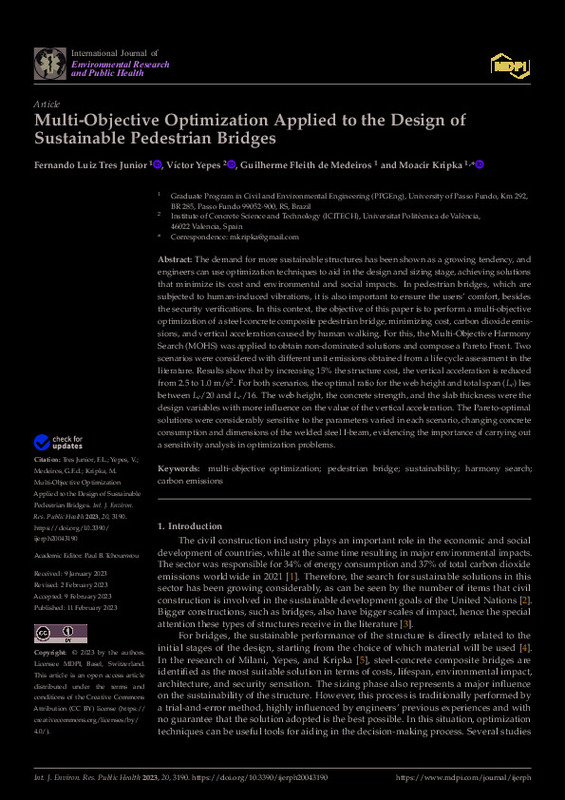JavaScript is disabled for your browser. Some features of this site may not work without it.
Buscar en RiuNet
Listar
Mi cuenta
Estadísticas
Ayuda RiuNet
Admin. UPV
Multi-Objective Optimization Applied to the Design of Sustainable Pedestrian Bridges
Mostrar el registro sencillo del ítem
Ficheros en el ítem
| dc.contributor.author | Tres Junior, Fernando Luiz
|
es_ES |
| dc.contributor.author | Yepes, V.
|
es_ES |
| dc.contributor.author | Medeiros, Guilherme Fleith de
|
es_ES |
| dc.contributor.author | Kripka, Moacir
|
es_ES |
| dc.date.accessioned | 2023-03-02T19:01:34Z | |
| dc.date.available | 2023-03-02T19:01:34Z | |
| dc.date.issued | 2023-02-11 | es_ES |
| dc.identifier.issn | 1661-7827 | es_ES |
| dc.identifier.uri | http://hdl.handle.net/10251/192256 | |
| dc.description.abstract | [EN] The demand for more sustainable structures has been shown as a growing tendency, and engineers can use optimization techniques to aid in the design and sizing stage, achieving solutions that minimize its cost and environmental and social impacts. In pedestrian bridges, which are subjected to human-induced vibrations, it is also important to ensure the users¿ comfort, besides the security verifications. In this context, the objective of this paper is to perform a multi-objective optimization of a steel-concrete composite pedestrian bridge, minimizing cost, carbon dioxide emissions, and vertical acceleration caused by human walking. For this, the Multi-Objective Harmony Search (MOHS) was applied to obtain non-dominated solutions and compose a Pareto Front. Two scenarios were considered with different unit emissions obtained from a life cycle assessment in the literature. Results show that by increasing 15% the structure cost, the vertical acceleration is reduced from 2.5 to 1.0 m/s2. For both scenarios, the optimal ratio for the web height and total span (Le) lies between Le/20 and Le/16. The web height, the concrete strength, and the slab thickness were the design variables with more influence on the value of the vertical acceleration. The Pareto-optimal solutions were considerably sensitive to the parameters varied in each scenario, changing concrete consumption and dimensions of the welded steel I-beam, evidencing the importance of carrying out a sensitivity analysis in optimization problems. | es_ES |
| dc.description.sponsorship | The authors received funding through grant PID2020-117056RB-I00 funded by MCIN/AEI/ 10.13039/501100011033 and by ERDF A way of making Europe; and the Brazilian National Council for Scientific and Technological Development (Grant CNPq306578/2020-4). | es_ES |
| dc.language | Inglés | es_ES |
| dc.publisher | MDPI AG | es_ES |
| dc.relation.ispartof | International Journal of Environmental research and Public Health | es_ES |
| dc.rights | Reconocimiento (by) | es_ES |
| dc.subject | Multi-objective optimization | es_ES |
| dc.subject | Pedestrian bridge | es_ES |
| dc.subject | Sustainability | es_ES |
| dc.subject | Harmony search | es_ES |
| dc.subject | Carbon emissions | es_ES |
| dc.subject.classification | INGENIERIA DE LA CONSTRUCCION | es_ES |
| dc.title | Multi-Objective Optimization Applied to the Design of Sustainable Pedestrian Bridges | es_ES |
| dc.type | Artículo | es_ES |
| dc.identifier.doi | 10.3390/ijerph20043190 | es_ES |
| dc.relation.projectID | info:eu-repo/grantAgreement/AEI/Plan Estatal de Investigación Científica y Técnica y de Innovación 2017-2020/PID2020-117056RB-I00/ES/OPTIMIZACION HIBRIDA DEL CICLO DE VIDA DE PUENTES Y ESTRUCTURAS MIXTAS Y MODULARES DE ALTA EFICIENCIA SOCIAL Y MEDIOAMBIENTAL BAJO PRESUPUESTOS RESTRICTIVOS/ | es_ES |
| dc.relation.projectID | info:eu-repo/grantAgreement/CNPq//CNPq306578%2F2020-4/ | es_ES |
| dc.rights.accessRights | Abierto | es_ES |
| dc.contributor.affiliation | Universitat Politècnica de València. Escuela Técnica Superior de Ingenieros de Caminos, Canales y Puertos - Escola Tècnica Superior d'Enginyers de Camins, Canals i Ports | es_ES |
| dc.description.bibliographicCitation | Tres Junior, FL.; Yepes, V.; Medeiros, GFD.; Kripka, M. (2023). Multi-Objective Optimization Applied to the Design of Sustainable Pedestrian Bridges. International Journal of Environmental research and Public Health. 20(4):1-15. https://doi.org/10.3390/ijerph20043190 | es_ES |
| dc.description.accrualMethod | S | es_ES |
| dc.relation.publisherversion | https://doi.org/10.3390/ijerph20043190 | es_ES |
| dc.description.upvformatpinicio | 1 | es_ES |
| dc.description.upvformatpfin | 15 | es_ES |
| dc.type.version | info:eu-repo/semantics/publishedVersion | es_ES |
| dc.description.volume | 20 | es_ES |
| dc.description.issue | 4 | es_ES |
| dc.identifier.pmid | 36833882 | es_ES |
| dc.identifier.pmcid | PMC9965771 | es_ES |
| dc.relation.pasarela | S\483032 | es_ES |
| dc.contributor.funder | AGENCIA ESTATAL DE INVESTIGACION | es_ES |
| dc.contributor.funder | European Regional Development Fund | es_ES |
| dc.contributor.funder | Conselho Nacional de Desenvolvimento Científico e Tecnológico, Brasil | es_ES |
| dc.subject.ods | 09.- Desarrollar infraestructuras resilientes, promover la industrialización inclusiva y sostenible, y fomentar la innovación | es_ES |








